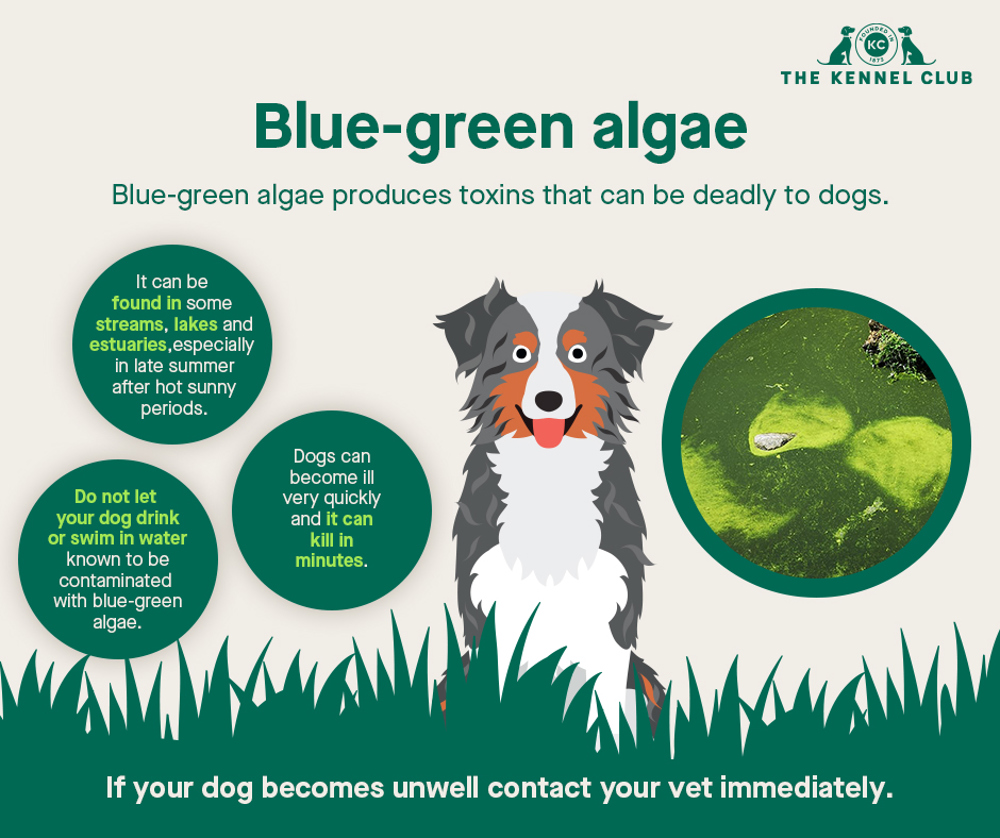
Blue-green algae, also known as cyanobacteria, has become a growing concern for dog owners around the UK. These algae blooms often occur in warm, stagnant freshwater sources such as ponds, lakes, or even backyard swimming pools. While it may appear harmless, it can be extremely toxic to dogs, leading to serious health issues and even death if not treated promptly.
A summary of blue-green algae
- Blue-green algae can be found in bodies of water such as lakes, ponds, and even some backyard pools.
- Blue-green algae can produce toxins that may be deadly to dogs
- Do not let your dog drink, or swim in, water that you think might be contaminated with blue-green algae
- If your dog becomes unwell, contact your vet immediately
What is blue-green algae?
Blue-green algae blooms occur naturally but are often triggered by warm weather, stagnant water, and excess nutrients from sources like agricultural runoff or fertilizers. The algae produce toxins known as cyanotoxins, which are responsible for poisoning animals and humans alike. Dogs are particularly vulnerable due to their curious nature and tendency to play in water.
Is blue-green algae toxic to dogs?
When a dog comes into contact with or ingests water contaminated with blue-green algae, they can quickly fall ill. The cyanotoxins can affect various organs, including the liver, kidney, and nervous system. Symptoms of blue-green algae poisoning in dogs can include vomiting, diarrhoea, difficulty breathing, excessive drooling, weakness, seizures, and even death within hours of exposure.
It is crucial for dog owners to be aware of the dangers and take preventative measures to protect their pets. Here are some steps you can take:
Stay informed
Keep yourself updated about any reported blue-green algae blooms in your area. Check with local authorities or Environment Agency for updates and warnings.
Avoid stagnant water
Keep your dog away from bodies of water that are known to have blue-green algae blooms. This includes lakes, ponds, and even decorative water features in parks or gardens.
Observe the water
When you are near water, be vigilant and look for signs of blue-green algae. It often resembles a thick, pea-green or blue-green scum on the surface of the water. It may also look like floating mats or clumps.
Restrict access
If you have a backyard pool, make sure to secure it with a fence or cover to prevent your dog from accidentally falling in. Similarly, be cautious when visiting unfamiliar places and keep your dog on a leash around bodies of water.
Rinse off after swimming
If your dog has been swimming, rinse them off with clean water to remove any potential residue of blue-green algae.
What does blue-green algae look like?
Water that contains blue-green algae may appear a different colour, often looking like pea soup. Blooms are not always large and can sometime be seen in smaller areas of the water close to the shore. The algae may be blue-green in colour, or can even be red, brown or black. The water may sometimes smell musty, earthy or grassy, and you may sometimes see foam along the shoreline.
Signs of blue-green algae poisoning in dogs
Blue-green algae poisoning in dogs, also known as cyanobacteria poisoning, occurs when dogs come into contact with and ingest toxins produced by algae blooms in bodies of water. If you suspect your dog may have been exposed to blue-green algae, be aware of the following signs of poisoning as vomiting, diarrhoea, dribbling. Dogs can appear weak, confused and lethargic, with a lack of energy and difficulty in standing, walking or breathing. In some cases, blue-green algae toxins can cause muscle tremors or twitching. Dogs may have an elevated heart rate or irregular heartbeat due to the effects of blue-green algae toxins on the cardiovascular system. Blue-green algae poisoning can be life-threatening and requires prompt treatment.
What should I do if my dog was exposed to blue-green algae?
- If you suspect that your dog has been exposed to blue-green algae, act quickly and seek immediate veterinary attention.
- Time is of the essence when it comes to treating cyanotoxin poisoning. If possible, get someone to call ahead to the vet to let them know you are on your way. This will give them time to prepare for when your dog arrives
- If you’re not near your home, you can find a vet near you on the Royal College of Veterinary Surgeon’s website
What should I do if I think a waterbody is contaminated by blue-green algae?
If you come across a body of water that you think may contain blue-green algae, do not go in it yourself, or let your dog swim in it or drink from it.
In the UK, incidents of blue-green algae should be reported to the Environment Agency which has a 24-hour incident hotline (telephone: 0800 80 70 60).
